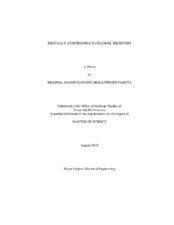| dc.contributor.advisor | Hoyos, Sebastian | |
| dc.creator | Pentakota, Krishna Anand Santosh Spikanth | |
| dc.date.accessioned | 2011-10-21T22:03:12Z | |
| dc.date.accessioned | 2011-10-22T07:08:41Z | |
| dc.date.available | 2011-10-21T22:03:12Z | |
| dc.date.available | 2011-10-22T07:08:41Z | |
| dc.date.created | 2010-08 | |
| dc.date.issued | 2011-10-21 | |
| dc.date.submitted | August 2010 | |
| dc.identifier.uri | https://hdl.handle.net/1969.1/ETD-TAMU-2010-08-8398 | |
| dc.description.abstract | This work presents a data estimation scheme for wide band multi-channel charge
sampling receivers with sinc filter banks together with a complete system calibration and
synchronization algorithm for the receiver. A unified model has been defined for the
receiver containing all first order mismatches, offsets and imperfections and a technique
based on least mean squares algorithm is employed to track these errors. The performance
of this technique under noisy channel conditions has been verified. The sinc filter bank is
compared with the conventional analog filter banks and it is shown that the sinc filter banks
have very low computational complexity in data estimation
Nextly, analytical tools for the design of clock-jitter tolerant multi-channel filterbank
receivers have been developed. Clock-jitter is one of the most fundamental obstacles
for the future generation of wideband receivers. Additionally all the trade-offs and
specifications of a design example for a multi-channel receiver that can process a 5 GHz
baseband signal with 40 dB of signal-to-noise-ratio (SNR) using sampling clocks that can
tolerate up to 5 ps of clock-jitter standard deviation are presented. A novel bandwidth
optimization technique has been presented. As a part of it the bandwidth of the filters present in each path is optimized thereby improving the performance of the receiver further
in the presence of sampling clock jitter. The amount of bandwidth reduction possible
depends on the order of the filter and the noise amplification provided by the reconstruction
matrix. It has been shown that 3rd order filters of bandwidth 1 GHz can be replaced with 1st
order filters of bandwidth 100 MHz without any depreciation in the output resolution,
implying huge power savings. | en |
| dc.format.mimetype | application/pdf | |
| dc.language.iso | en_US | |
| dc.subject | sinc | en |
| dc.subject | filter | en |
| dc.subject | multi-channel | en |
| dc.subject | receiver | en |
| dc.title | Digitally Assisted Multi-Channel Receivers | en |
| dc.type | Thesis | en |
| thesis.degree.department | Electrical and Computer Engineering | en |
| thesis.degree.discipline | Electrical Engineering | en |
| thesis.degree.grantor | Texas A&M University | en |
| thesis.degree.name | Master of Science | en |
| thesis.degree.level | Masters | en |
| dc.contributor.committeeMember | Silva-Martinez, Jose | |
| dc.contributor.committeeMember | Li, Peng | |
| dc.contributor.committeeMember | Friesen, Donald K. | |
| dc.type.genre | thesis | en |
| dc.type.material | text | en |


